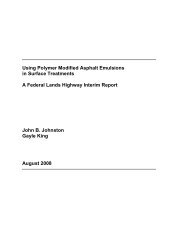Handbook for Bridge Inspections - TSP2
Handbook for Bridge Inspections - TSP2
Handbook for Bridge Inspections - TSP2
Create successful ePaper yourself
Turn your PDF publications into a flip-book with our unique Google optimized e-Paper software.
Major <strong>Inspections</strong><br />
Whenever carbonisati on is suspected as a problem, spot tests<br />
should be undertaken over a sufficientl y large area so as to be abl e<br />
to conclude whether carbonisation is/is not a problem <strong>for</strong> the bridge<br />
in question. Should these suspicions be confirmed then the<br />
scope of the testing can be en larged. In add ition measurements<br />
should be taken of the cover (compare Chapter 7.3.1 <strong>for</strong> the recor·<br />
ding of the extent of the earbonisation). As an alternative a special<br />
inspection can be requisitioned.<br />
Special <strong>Inspections</strong><br />
The depth of the carbon isation is to be measured in accordance<br />
with special instructions. The extent and location should be adap·<br />
ted to during execution of the inspection.<br />
Advantages and<br />
Disadvantages<br />
Eq uipment<br />
The method is quite simple but req uires cutting or dri ll ing of the<br />
structure.<br />
• A I % solution of phenolphthalein, or possibly I gm. phenol ph<br />
tha lein in all. mixture of water (50%) and ethanol (50%).<br />
• Spray bottle<br />
• Fold ing n ile<br />
• Slidingcall iper<br />
• Hammer<br />
• Chi se l<br />
• Pure water<br />
• Material and equipment <strong>for</strong> refi lling holes<br />
• Core drilling equipment, ifnecessary<br />
7.3.3 Measuring Chloride Content<br />
Pu rpose<br />
To measure the chloride content of hardened concrete at various<br />
depths so as to evaluate the risk of corrosion of the rein<strong>for</strong>cement<br />
or 10 uncover the cause of damage.<br />
The penetration of chloride wil l cause corrosion of the re in<strong>for</strong>cement<br />
in the event of the chloride concentration becoming too hi gh.<br />
The limit <strong>for</strong> critical chloride content, namely a level wh ich can<br />
lead to corrosion of the rein<strong>for</strong>cement, was earl ier assumed to be<br />
around 0.06% of the weight of the concrete (0.4% of the weight of<br />
the cement). However, ex perience gained fro m the bridges mana·<br />
ged by the Public Roads Admini stration indicates that the chloride<br />
content can be much higher without the occurrence of damaging<br />
corrosion of the rein<strong>for</strong>cement.<br />
The following circumstances are of significance <strong>for</strong> the speed of<br />
corrosion and must be considered in conj unction with the recorded<br />
chl oride content:
















